Abraham Moss

16 Ap 1859 to 25 Jan 1917
On November 26, 2018 I climbed the steep hill of Birchcliffe Road above Hebden Bridge. I was in search of several buildings that had been lived in, and in some cases specifically built for, my ancestors. Yes, these are quite distant ancestors, but at this gloomy time of year when it’s dark by 3:30 p.m. going in search of houses that I can walk to from my apartment is an interesting way to spend some of the daylight hours, and so then in the evening, I can research online more about what I’ve discovered during the day. So as I searched the street perched on the hillside with one of the best views in town, which I later, by the way, learned was known as Snob Row (!) I saw a sign on a gate: ‘Brooklyn. Please use the back door. These steps are dangerous.’ I’m not sure what caused me to take a photo of the sign on the gate but recently I discovered that these steps had played a very important role in the life, or rather, death of one Abraham Moss.
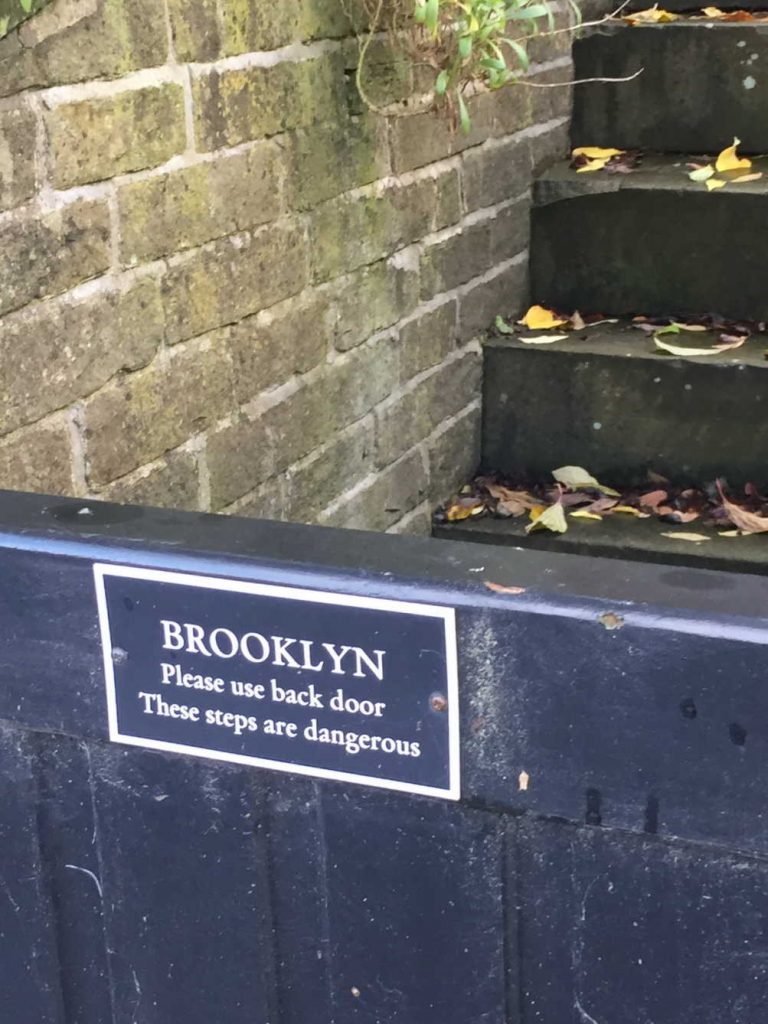
Now Abraham was the father-in-law of my 3rd cousin, two times removed. As I said, a rather distant relative. He was the son of Hague Moss, (26 June, 1824- July 1870) a career fustian cutter, born at Machpelah, a section of Hebden Bridge devoted to the fustian industry. Hague’s father was James Moss jn (1804-1868) and his wife, Mary. Fustian is a thick, hard-wearing cloth made from cotton that was once used for military uniforms and railway workers. Hebden Bridge was the centre of the fustian industry and was known sometimes as Fustianopolis. In the market square there’s a large sculpture of a fustian knife showing what a central role this industry played in the town.
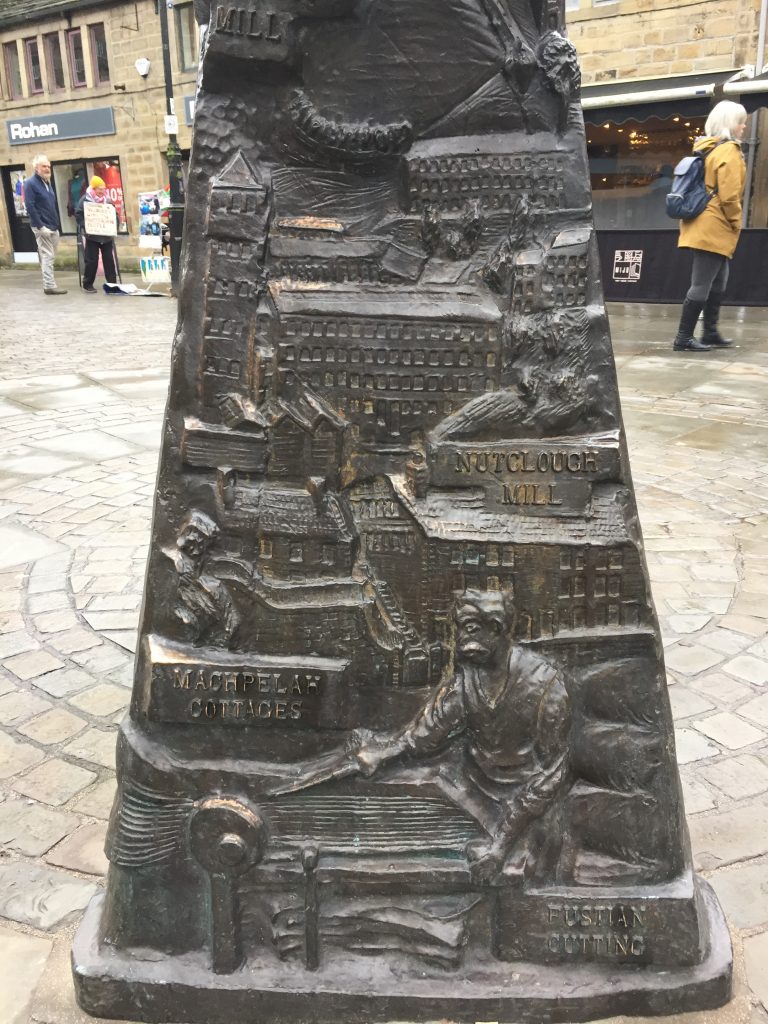
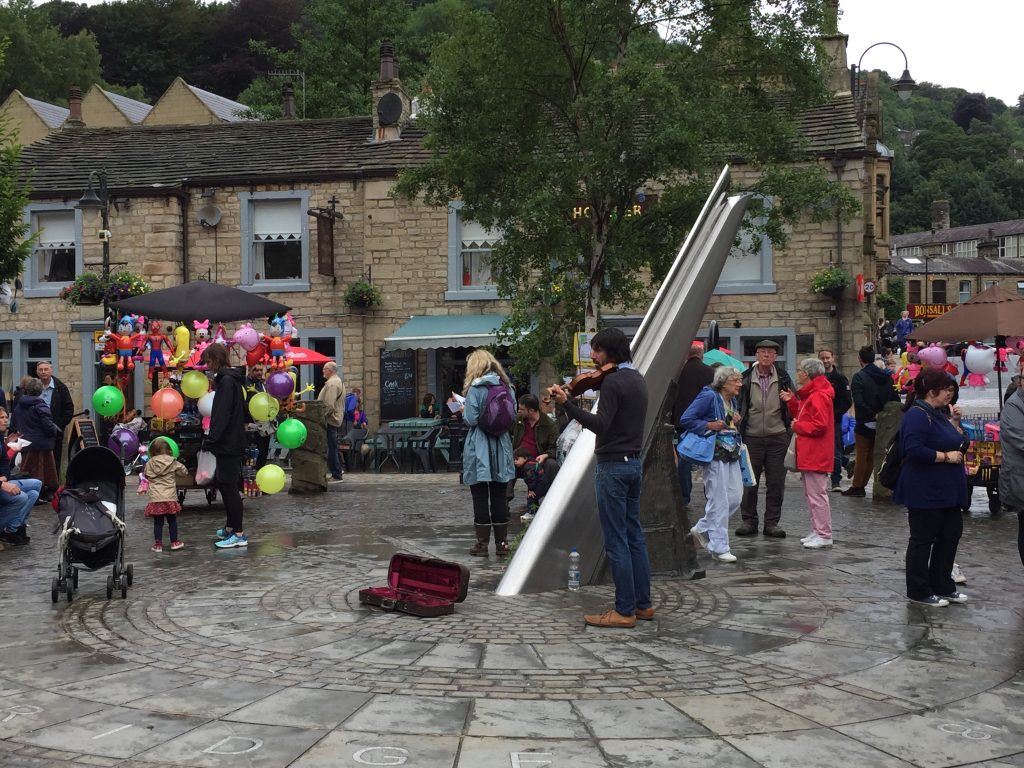
By the time Hague was four years old the family had moved to Thorn Bank, close by, where Sarah and I had stayed in an Airbnb in 2017! Coincidence number 2.

Thorn Bank where Sarah and I stayed in 2017 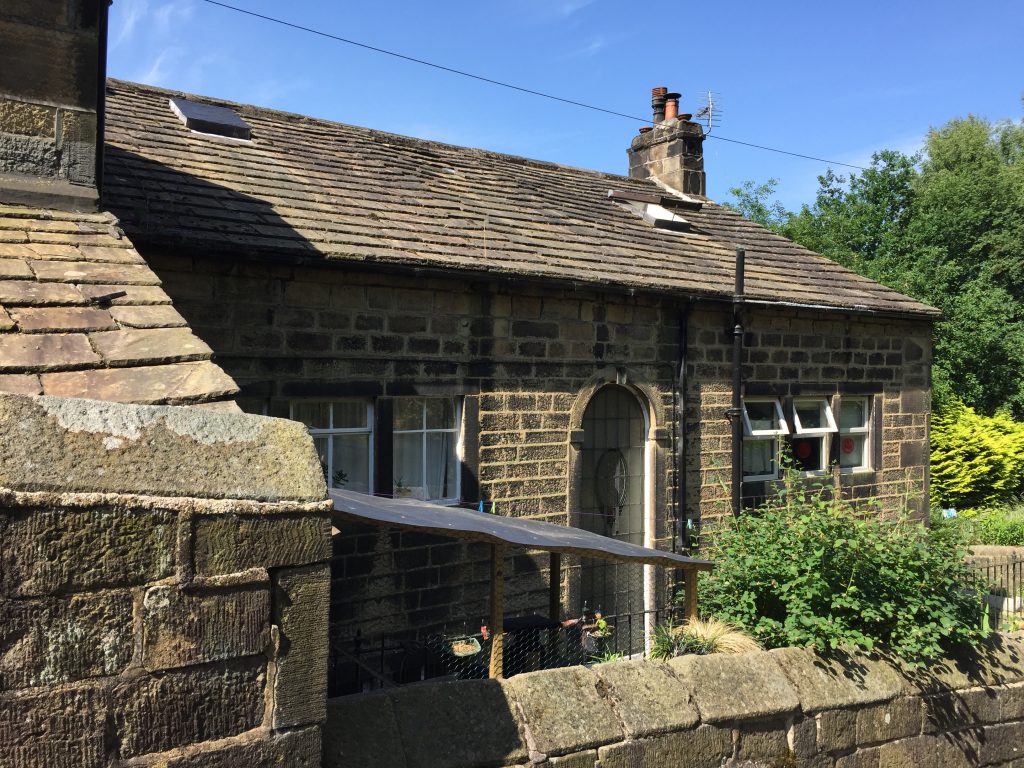
Thorn Bank 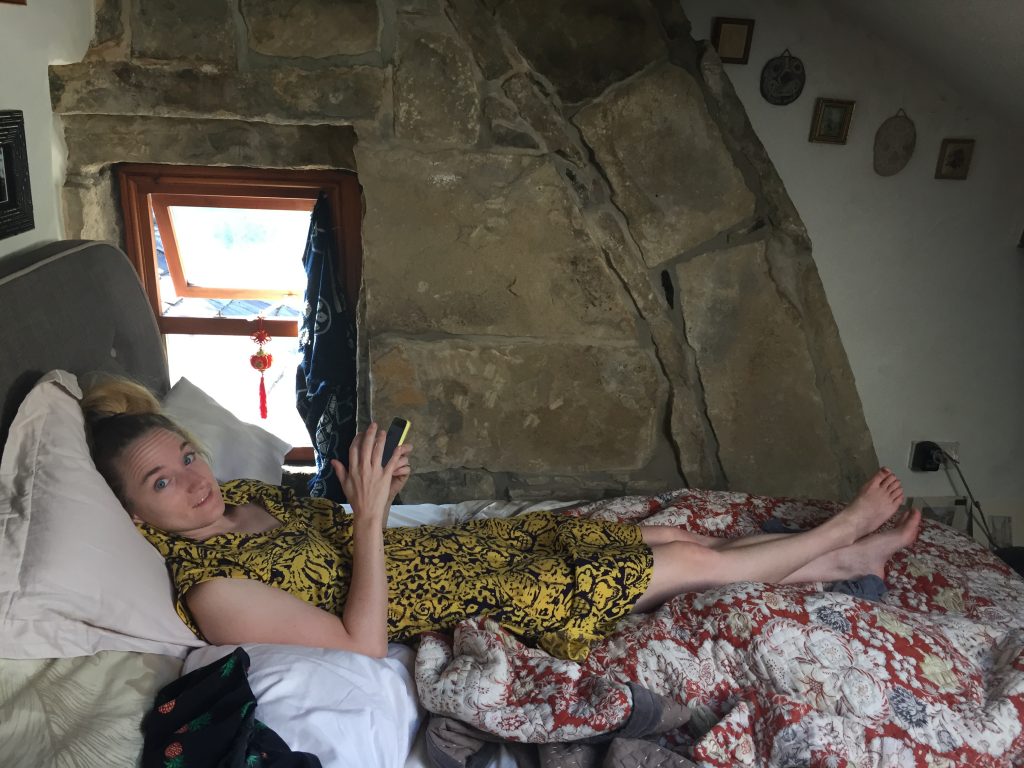
Sarah in the attic at Thorn Bank
By 1841 the family were living at Garden Square and Hague’s father James is a fustian cutter. They were living next to William Wheelhouse, 45, a joiner with his wife, Mary, and 4 children. Hague Moss married Martha Sarah Wheelhouse on June 23, 1845 at Halifax minster where I once had the privilege of playing the organ, and I’ve also sung at evensong, and also in Faure’s Requiem in 2019.
The newly weds made their home in Garden Square which is now merely a car park which doubles as the outdoor market on Thursdays and the flea market on Fridays.
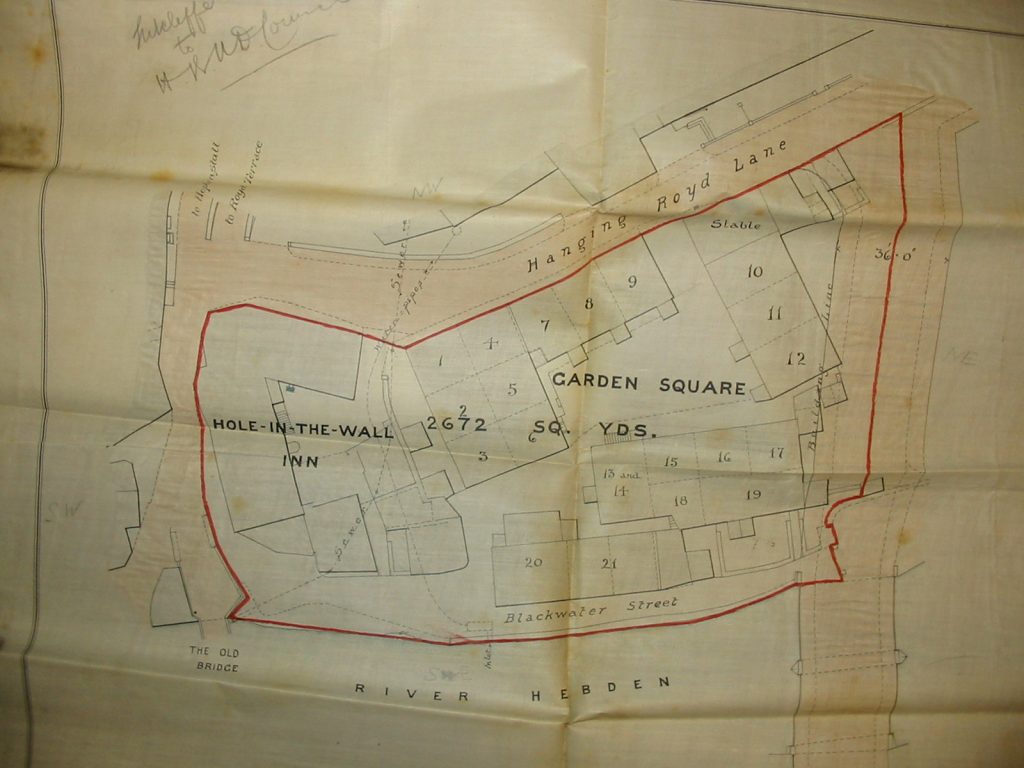
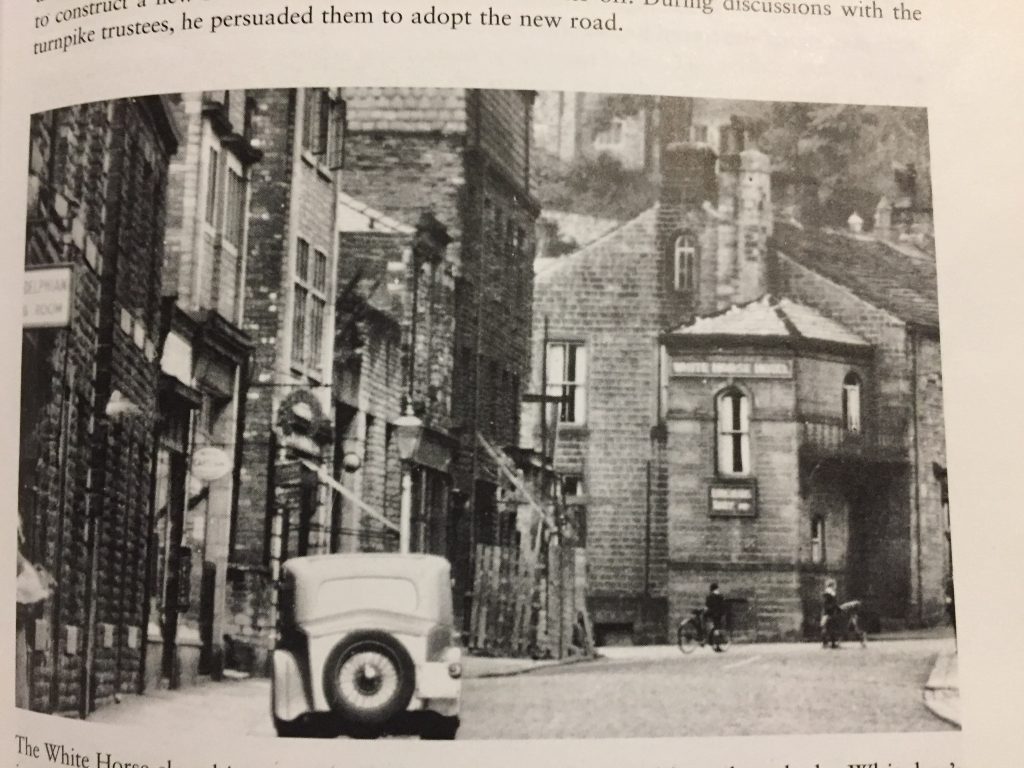
8 children followed in the next 15 years, Abraham being next to the youngest. By the time Abraham was born the family were living at High Street, Bridge Lanes. The area of Bridge Lanes was mostly demolished in the 1960’s the terraced houses having been neglected and left unoccupied for many years and it had become an unsightly entrance to Hebden Bridge from the Todmorden side. Abraham’s father died when he was only 11 years old and by that time the family had moved to Royd Terrace, at the lower end of the Buttress, the still cobbled steep road up to Heptonstall.
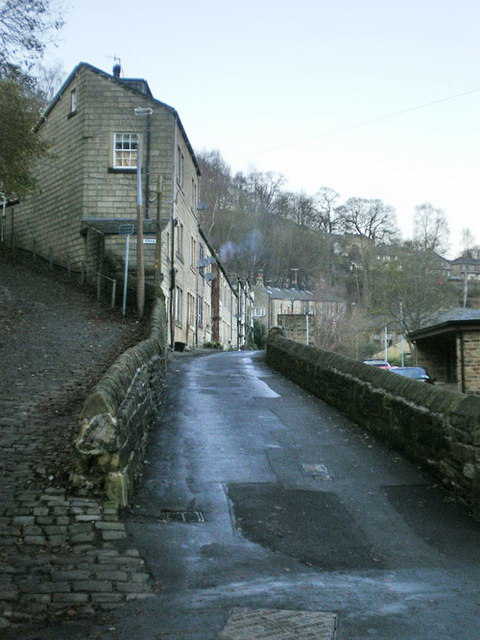


Abraham’s house on Royd Terrace 
During the battle of Heptonstall in the Civil War, 1643, the Parliamentarian garrison of around 800 men holding Heptonstall had rolled stones down The Buttress to prevent the Royalist forces, also numbering around 800 men. The attackers were routed but during the following 2 months the Parliamentarian garrison evacuated the village and the Royalists were able to capture the village with no resistance.

Heptonstall old church
The houses of Royd Terrace in which Abraham had lived were now built until 1848-1852 and all but one house retain their original glazing
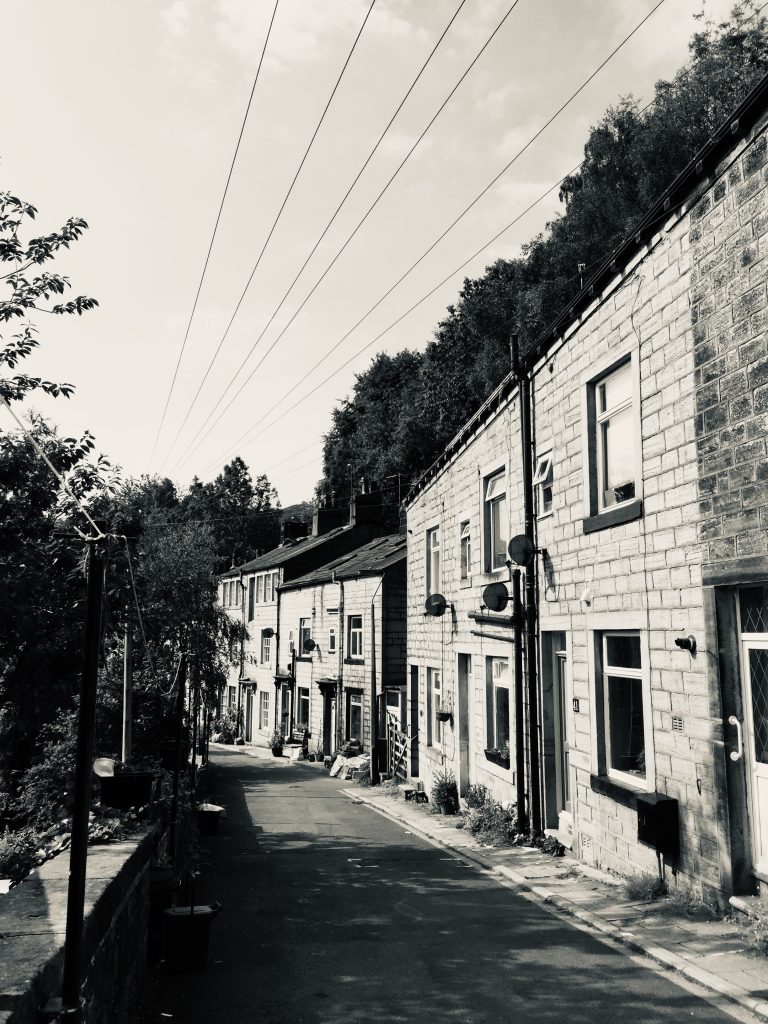
A friend of mine lived in the only one to have double glazing installed. On his marriage, in 1881 at Heptonstall church, (where I am now on the organists’ rota) to Mary Hannah Thomas, daughter of Thomas Thomas (!) a coal merchant, the couple moved to Barker’s Terrace. Both Abraham and Mary signed their own names and Thomas Thomas signed as witness.
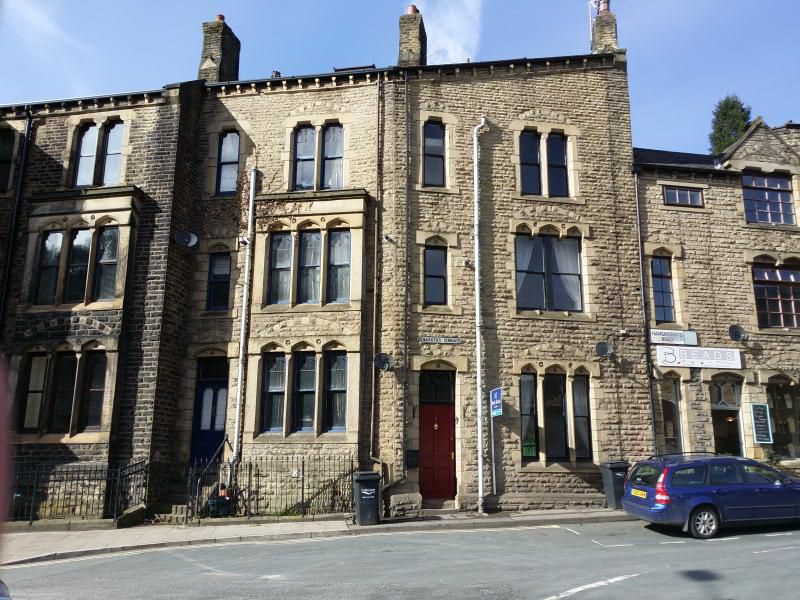
Abraham was a commercial clerk in a fustian warehouse. Three months after their wedding their first of seven children was born, a daughter, Beatrice Louise at 13 Melbourne Street.
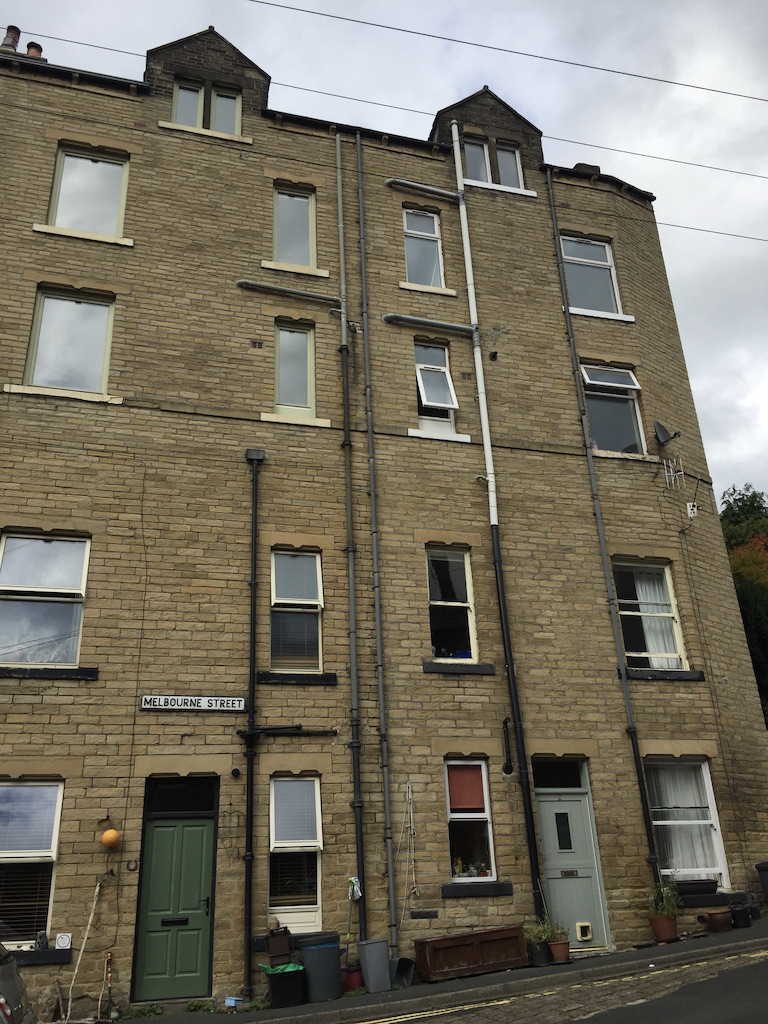
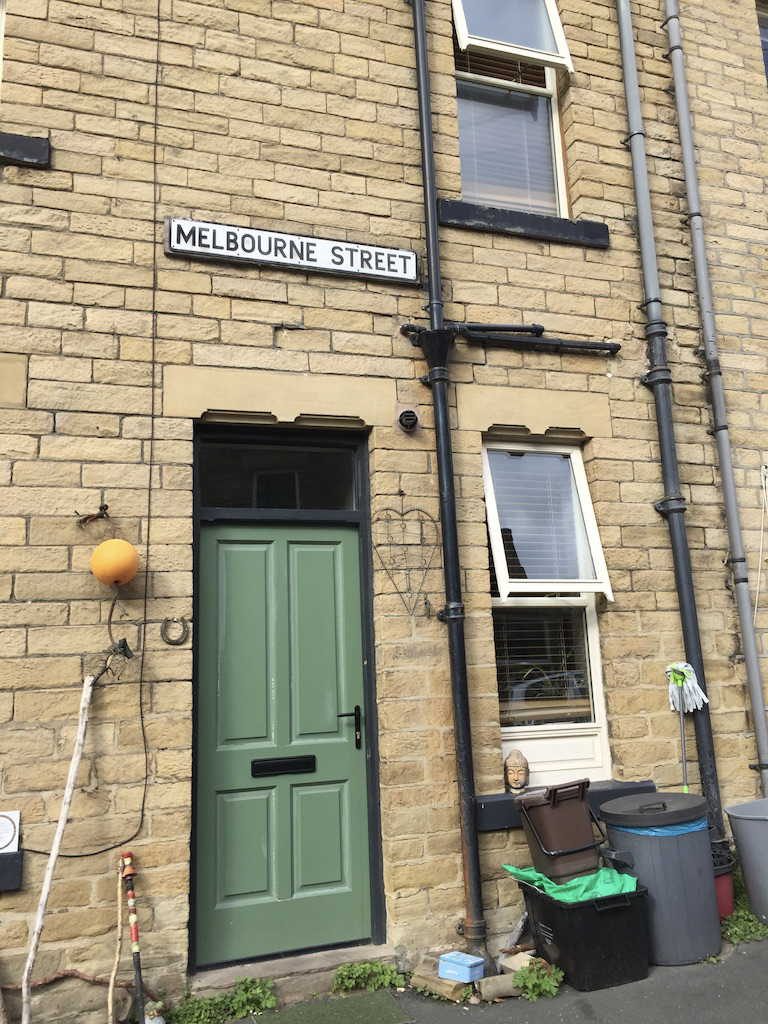
In White’s 1887 Directory many Mosses are recorded:
Moss Abraham (Bros) h in Brunswick Terrace
Moss Bros. fustian manufacturers and cutters, Brunswick Works
Moss( G. F & C. W) h Bridge Lanes
Moss Frederick Hague (Bros) h Brunswick St
Moss George Frederick (G.F & C.W) h Bridge Lanes
Moss James (Bros) h Pleasant Villas
Moss Mortimer (bros) h Brunswick House

My the 1901 census Abraham is listed as a cotton fustian manufacturer, an employer, and later that year a daughter, Phyllis Margaret was born, seven years after the last (living) child. The 1911 mentions that one child has already died. He is now living on Snob Row, in Brooklyn, where I’d photographed the sign on the gate. The house had 9 rooms and they had a live-in general servant. What a difference from 2 High Street. I was able to view the plans for the house at West Yorkshire Archives though each leaf fell apart in my hands as I opened it. It would appear that the plans were drawn up by John Sutcliffe, architect, on December 20, 1894 but the approval date of December 27, 1894 has been crossed out. This was the same architect who drew up the plans from Ezra Butterworth five years earlier. But what an extravagant house it was – especially compare to the houses Abraham had lived in before.
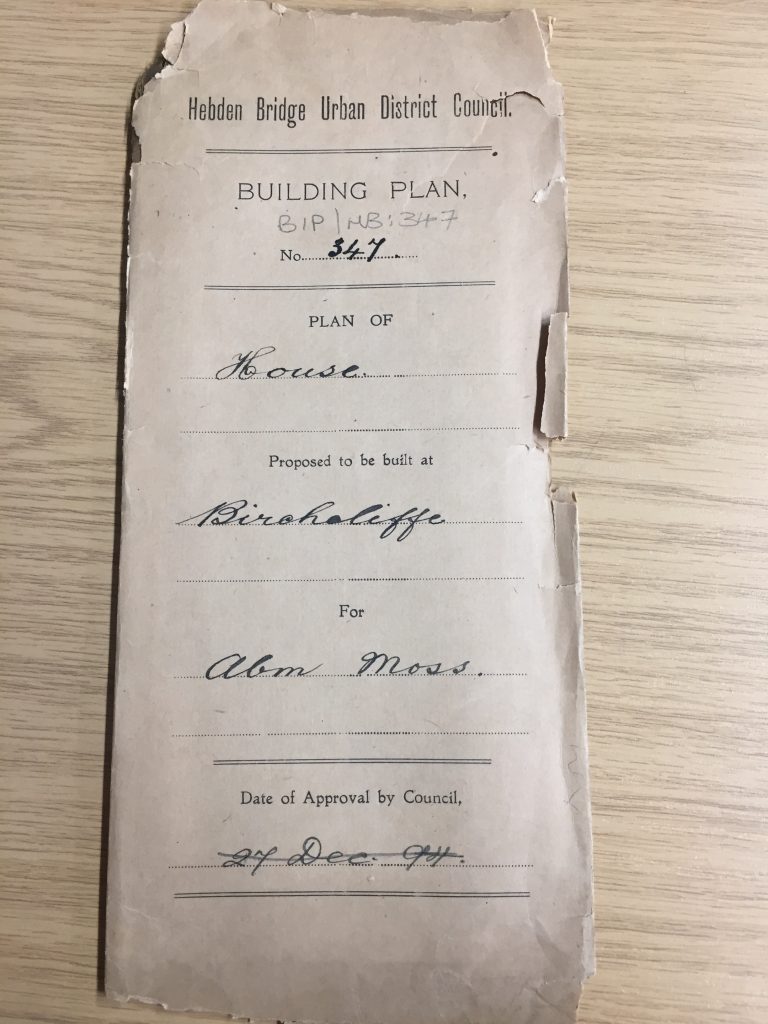
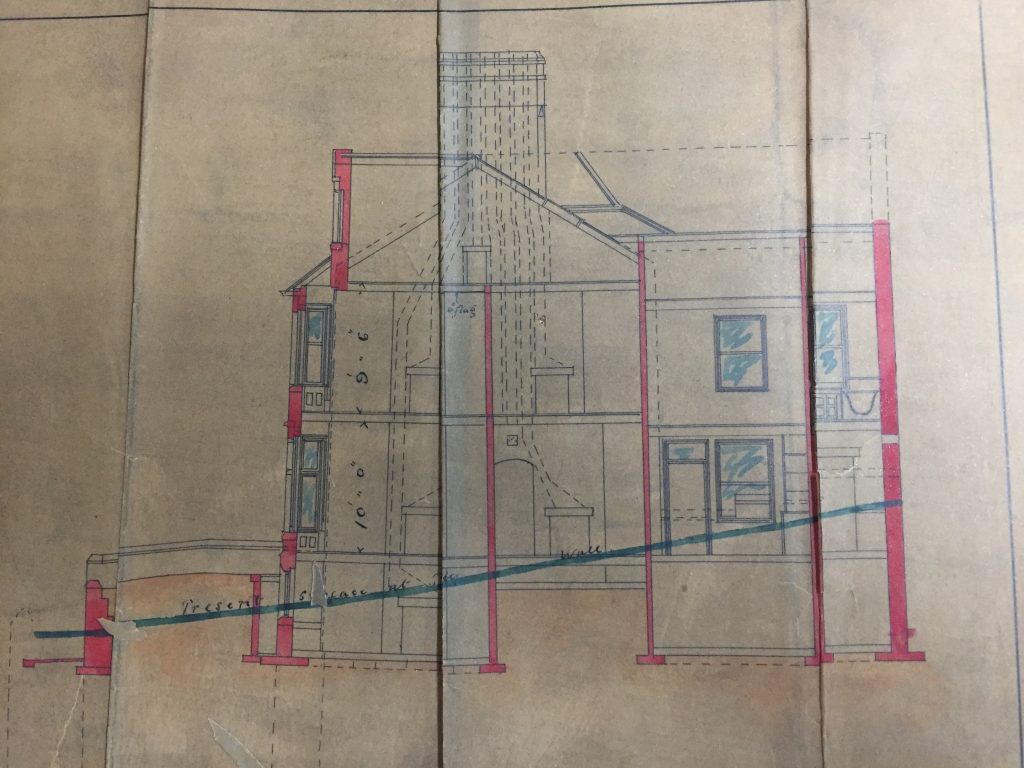
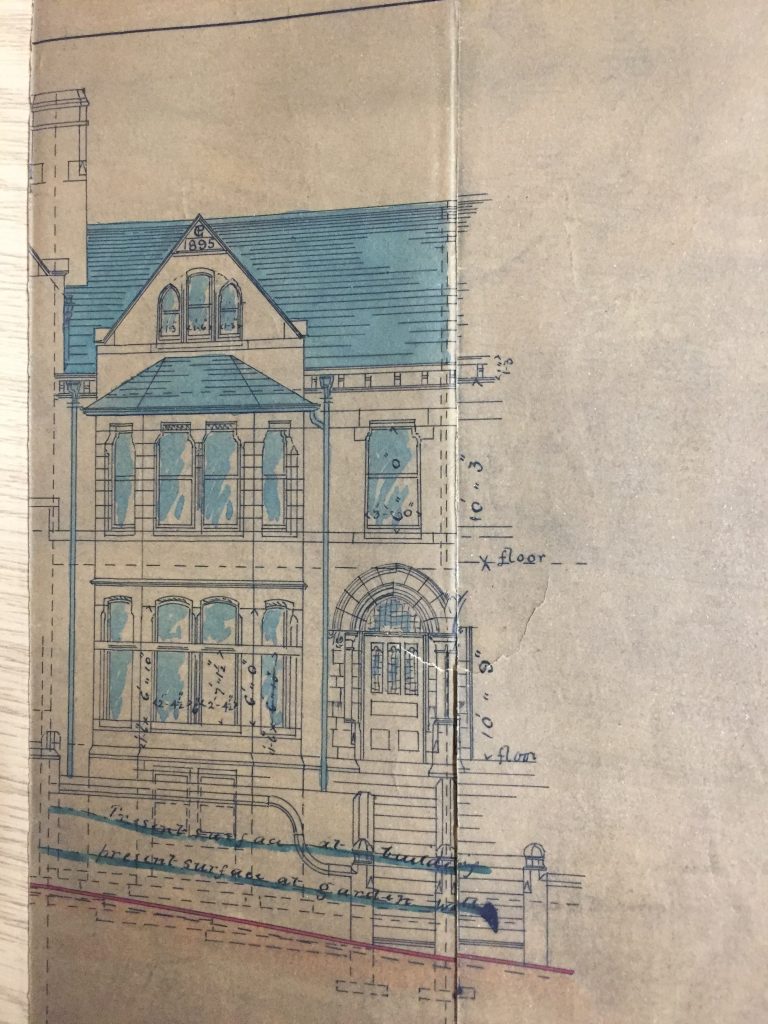
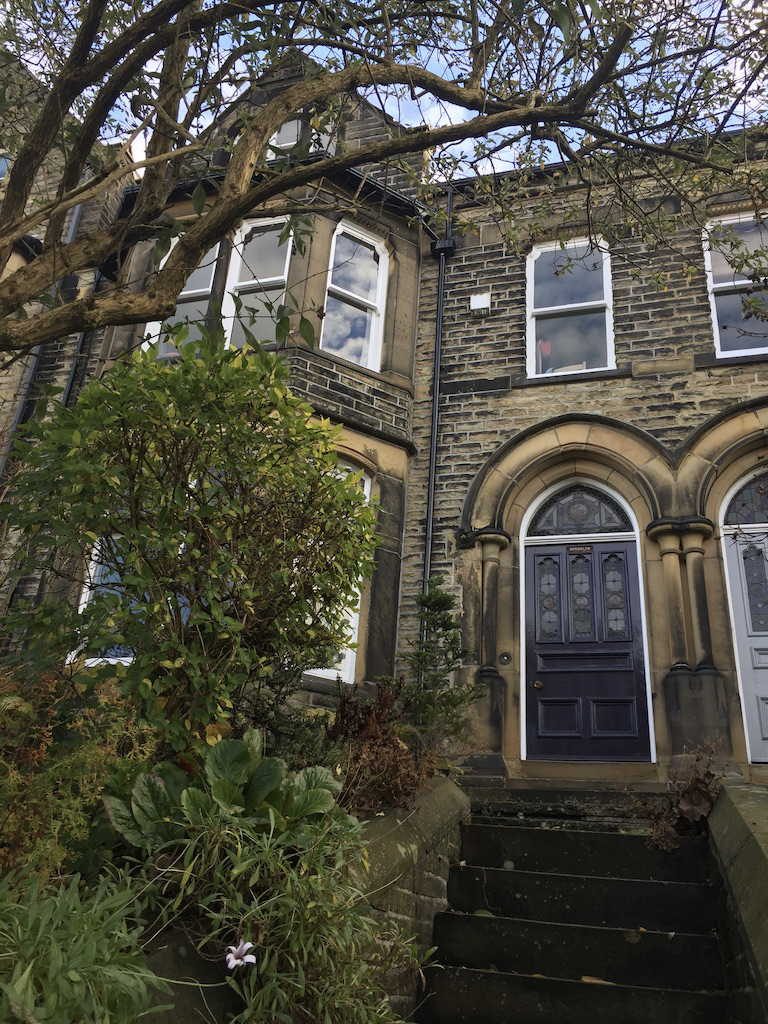
However, sadness and tragedy were just around the corner for the family. Phyllis died, aged 13 and three years later Abraham himself died. Imagine my horror when I read in a local newspaper that he had died as a result of falling down those very steps. I do wonder, from a morbid sense of curiosity, if the people who put the notice on the steps know of Abraham’s accident.
FATAL FALL AT HEBDEN BRIDGE. SAD END OF A WELL-KNOWN We very much regret to have to announce the death of Mr. Abraham Moss, Brooklyn, Hebden Bridge, and especially so considering the melancholy circumstances under which happened. The gentleman on Wednesday evening was found laid in an unconscious condition at the foot of the steps leading to his own house, with a deep gash on the side of his head, and from this injury he died at two o’clock yesterday morning without regaining consciousness. So far as we can gather from particulars collected from various sources the circumstances are these: Mr. Moss had been down in the town and parted from Mr. A. Moore at Top o’ th’ Hill about ten o’clock on his way home. In the course of half an hour or so, Mr. T. Fenton Greenwood was on his way home to Eiffel Street, and when he got opposite to the gate the residence Mr. Moss he heard some deep breathing, bat as he had no means of making a light and the night being very dark, he could not make out any object. Mr. Ernest Whiteoak, Eiffel St., came up almost immediately afterwards, and struck match and the light revealed Hr. Moss laid at the bottom of a flight of dosen steps, with his head resting in a large pool blood and perfectly unconscious. On the right side of his head there was a large wound from which the blood was issuing. Mrs. Moss was acquainted with the facte and her husband was carried to the house and Dr. Sykes summoned, and that gentleman found that Mr. Moss was suffering from fractured skull. Whether he had fallen from the top of the steps or not does not appear clear, but the sloping asphalt from the top of the steps was very .ppory. Judging from the position the body it would appear that Mr. Moss had fallen backward and his head had either struck the wall or the steps in his fall. The facts have been reported to the Coroner. The news of the sad occurrence created quite sensation in the town yesterday morning. * Mr. Moss was well known in Hebden Bridge and district. He was the younger son the late Mr, Haigh Moss, and many years was associated with his brothers in tile fustian manufacturing, dyeing and finishing business at Brunswick Street, Lee Mill and Bridge Boyd, up to few years ago, when he retired, and since then he has not followed any occupation. He was one the .directors of the English Fustian Association up to the time his death. For good many years he had been one of the local representatives on the Todmorden Board of Guardians. He was first elected in 1898, and remained member up to 1910. Three years later he was again elected, and had been a Guardian ever since. He took great interest the affairs of that body, and for a term was its chairman. For many years he was a very active member of the Hebden Bridge Commercial Association. He was an enthusiastic member the local Angling Club. Though he associated himself with the Constitutional Club he did not take any part in the aggressive work of the Conservative party. Free Masonry claimed a considerable portion of his time, he having filled offices in the Prince Frederick Lodge. He was one of the band of young men who received a considerable portion of their education the classes held in connection with the defunct Hebden Bridge Mechanics’ Institute. He took interest in electricity, and according to bis own story, he along with the late Mr. B. 8. Blackburn installed the first telephone in Hebden Bridge, connecting the house of one of his brothers to the firm’s premises. He was closely associated with the Particular Baptist Church, and was good supporter of that institution. His nature was kindly and sympathetic and he was ever ready to give financial assistance when occasion demanded it, and in this way he has displayed a liberal generosity. Mr. Moss, who was 67 years of age, leaves widow and five children. Two his sons are serving in the army, Walter in France and Reginald in India. The inquest will he held to-morrow afternoon.
When he died he left just short of 40,000 pounds to his wife. This was in 1917 and many of the other people on that page of the probate records had just a few hundred pounds to their name. He was initiated into the Prince Frederick Free Masons Lodge on March 3, 1890 along with Richard Redman, clothier from Pleasant Villas, and James Moss, fustian manufacturer, also from Pleasant Villas.
From The Hebden Bridge Times, January 30, 2006
WHEN the history of Fustianopolis – alias Hebden Bridge – comes to be written, it will be recorded that it died of apathy. I have now been waiting in vain for a month for somebody hereabouts to protest about the East Anglian train operator, One, banning cab drivers from wearing corduroy.
Under new licence conditions, cabbies at Lowestoft and Great Yarmouth stations must wear black trousers and black shoes with a collared or polo shirt. For women the regulations require a black skirt and blouse with a collar. No corduroy, not even black corduroy.
The company says: “Cords were included in the list of unacceptable clothing as they can look quite scruffy when they get faded. When the guidelines were being clarified, it was noticed that several drivers were wearing light coloured cords which had frayed and looked quite nasty at the knees”.
This is a bit lame. Are they objecting to corduroy or to fraying corduroy? If the latter, then they could simply have prescribed smart corduroy instead of banning it outright.
This is – or should be – of serious concern to Hebden Bridge. Nowhere has more corduroy been woven per head of population than in this town. My parents and several aunts wove miles of it on Hangingroyd at the CWS and Ashworth’s below where Foster Lane chapel once stood. My father went deaf in the service of corduroy and my aunts emerged from kissing shuttles in the CWS with a halo of cotton fuzz collected in their hair.
Corduroy was the life’s work of so many of my parents’ generation, and to think it has come to this: banned by the transport industry for being scruffy. Of course, anything can look scruffy if it is worn long enough. But that is no reason to ban corduroy that retains its rib (with musical consequences when you walk) and its sheen. Perhaps the problem is that it takes long periods of hard duty to wear thin.
Corduroy has, in fact, gone up in the world since it was the uniform of the academic, the Leftie intelligentsia, if that is not a contradiction in terms, and the wild and woolly end of the sandal-shod Liberal Democrats. It has, indeed, been on a long upward social march since it clothed the navvy and hard working man and had the likes of George Orwell, author of 1984, the Road to Wigan Pier etc, dressing, according to Malcolm Muggeridge, in the manner of the class into which he wished he had been born.
The fact that I have three pairs of corduroy trousers – the latest in a long line going back to my childhood – is no guide to the fabric’s social standing. I believe in supporting home industries and regard jeans, with their marked tendency for the backside to sag alarmingly, as thoroughly sloppy.
Which brings me back to the shameful apathy of Hebden Bridge in the face of East Anglian provocation. Corduroy is not some foreign-produced relic of Hebden Bridge’s once central position in the fustian trade. It is part of the 1m metres – otherwise 621,504 yards or 353 miles – of cloth that Brisbane Moss weaves, dyes and finishes every year at Bridgeroyd Works, Eastwood.
Hang it all, corduroy is part of our heritage. Since the middle of the 19thC, Moss Brothers – now Brisbane Moss – has been producing it along with moleskins. This company became part of the English Fustian Manufacturing Co when the local trade re-organised to meet the competition from another amalgamation of clothing and dyeing companies called the English Velvet Cord Dyeing Company.
Moss Brothers Brunswick Mill in Hebden Bridge may now be a Co-op superstore. But Bridgeroyd Works remain our link with the Industrial Revolution. And I for one do not intend to allow some obscure railway company on the Broads to disparage its Pennine products. Wear corduroy with pride – and in protest.
Just to see the contrast between the home in which Abraham was born and the one where he died shows the strength of character and determination of the man.
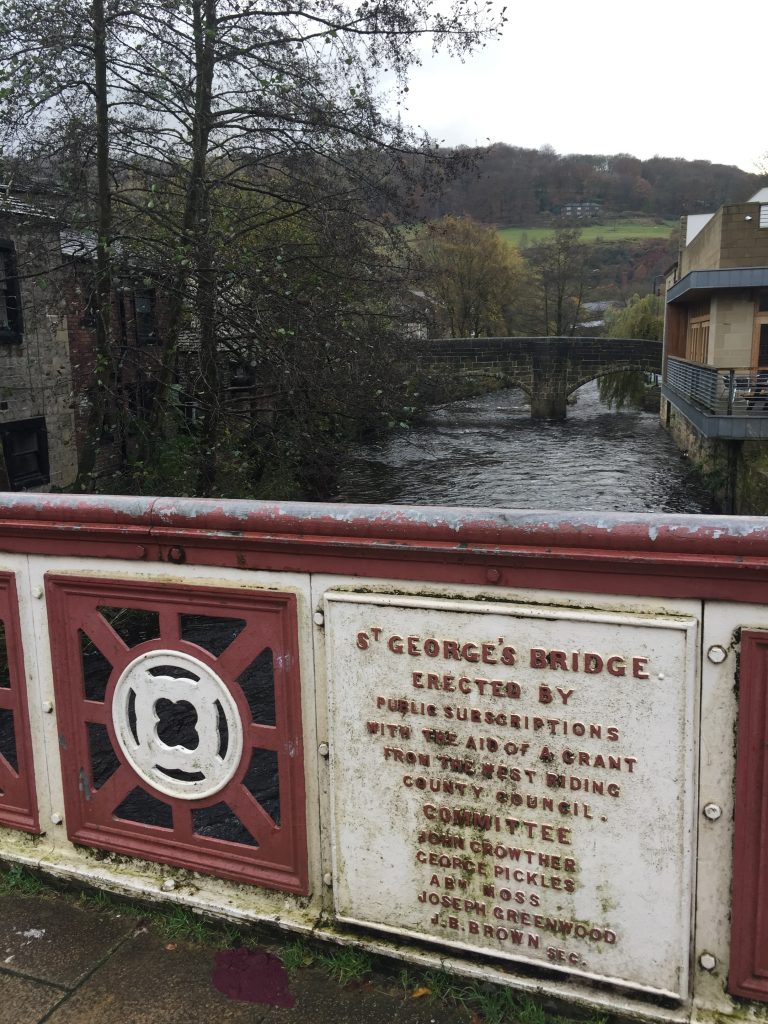
Hi Heather – an enjoyable post, thanks.
Was a bit spooked at first to see that Abraham had lived at 35 Royd Terrace and then 13 Melbourne Street. I lived at 13 Melbourne Street and then 35 Royd Terrace! Sorry about the mess outside RT that shows on your photos – was (still am really) doing it up.
Found some bits and pieces of history under the floorboards/up the chimney etc. But nothing from that far back unfortunately.
All the best
Mike
What an amazing coincidence! I just love things like that. How did you come across my blog?
I was brought up in Brooklyn 1964 to 1980. My mum was Sheila who was chair of the local council.
Loved your story! My great great great grandfather was William Wheelhouse and his son Abraham was 12 when they were living in Garden Square. Abraham arrived in Australia in 1857 with his wife Jane Collinge.
Thanks again.
Gary
Hello Cousin,
Abraham Moss was my great, great grandfather. I have a copy of our family tree, done by my Uncle, Brian Hague Moss, which goes back to the 1770’s. It is about fifteen feet wide when fully rolled out. My father worked in the Moss Brothers of Hebden Bridge company until the 1960’s. Sadly, he has just died, aged 91, hence me searching for interesting information to include in his eulogy.
Hi, I’ve just found this blog on the Moss family. I am a great great granddaughter of Elizabeth Cockcroft (nee Moss), daughter of James Moss. I have some original letters addressed at Machpelah of my great grandmothers Elizabeth 1865 and original birth certificates of family members Thorn Bank, Wadsworth. I have several original birth and marriage certificates of Cockcroft’s handed down by my father from Hebden who himself once lived in Bridge Lanes, also Burless Lane high above Hebden. I know very little of my Hebden great grandparents or indeed Cockcroft’s however my son is studying for his PhD in Astrophysics at Sussex, he turned down and offer from Manchester only to discover one John Douglas Cockcroft Manchester astrophysicist from Todmorden helped split the atom. Such a coincidence must have passed on the gene haha. Could you possibly help with any of this, filling in blanks, any information would be so interesting. I’m originally from Huddersfield but lived in London since 1983.
Hi there, loving the blog, but you have a small, but important detail incorrect, the part with the map of Garden Square and you say ‘The newly weds made their home in Garden Square which is now merely a car park which doubles as the outdoor market on Thursdays and the flea market on Fridays’, but Garden Square was actually where the Town Hall is now, not at the car park/market site.
This is very interesting. I remember a Miss Moss who lived at Brooklyn . She was a lovely lady I used to visit her.
Hi when was that? I lived in Brooklyn 1964-1980
Was the sign about the steps being dangerous there when you lived there? Were you aware of Abraham’s story when you lived there?